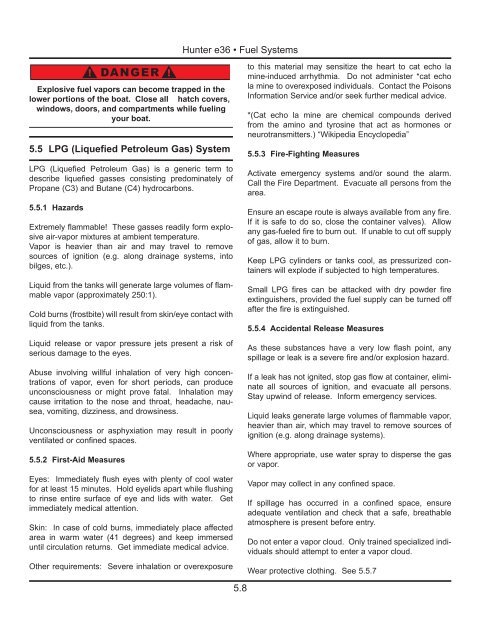36e Operator's Manual 2013.pdf - Marlow-Hunter, LLC
36e Operator's Manual 2013.pdf - Marlow-Hunter, LLC
36e Operator's Manual 2013.pdf - Marlow-Hunter, LLC
- No tags were found...
Create successful ePaper yourself
Turn your PDF publications into a flip-book with our unique Google optimized e-Paper software.
! DANGER !Explosive fuel vapors can become trapped in thelower portions of the boat. Close all hatch covers,windows, doors, and compartments while fuelingyour boat.5.5 LPG (Liquefied Petroleum Gas) SystemLPG (Liquefied Petroleum Gas) is a generic term todescribe liquefied gasses consisting predominately ofPropane (C3) and Butane (C4) hydrocarbons.5.5.1 HazardsExtremely flammable! These gasses readily form explosiveair-vapor mixtures at ambient temperature.Vapor is heavier than air and may travel to removesources of ignition (e.g. along drainage systems, intobilges, etc.).Liquid from the tanks will generate large volumes of flammablevapor (approximately 250:1).Cold burns (frostbite) will result from skin/eye contact withliquid from the tanks.Liquid release or vapor pressure jets present a risk ofserious damage to the eyes.Abuse involving willful inhalation of very high concentrationsof vapor, even for short periods, can produceunconsciousness or might prove fatal. Inhalation maycause irritation to the nose and throat, headache, nausea,vomiting, dizziness, and drowsiness.Unconsciousness or asphyxiation may result in poorlyventilated or confined spaces.5.5.2 First-Aid MeasuresEyes: Immediately flush eyes with plenty of cool waterfor at least 15 minutes. Hold eyelids apart while flushingto rinse entire surface of eye and lids with water. Getimmediately medical attention.Skin: In case of cold burns, immediately place affectedarea in warm water (41 degrees) and keep immerseduntil circulation returns. Get immediate medical advice.Other requirements: Severe inhalation or overexposure<strong>Hunter</strong> e36 • Fuel Systems5.8to this material may sensitize the heart to cat echo lamine-induced arrhythmia. Do not administer *cat echola mine to overexposed individuals. Contact the PoisonsInformation Service and/or seek further medical advice.*(Cat echo la mine are chemical compounds derivedfrom the amino and tyrosine that act as hormones orneurotransmitters.) “Wikipedia Encyclopedia”5.5.3 Fire-Fighting MeasuresActivate emergency systems and/or sound the alarm.Call the Fire Department. Evacuate all persons from thearea.Ensure an escape route is always available from any fire.If it is safe to do so, close the container valves). Allowany gas-fueled fire to burn out. If unable to cut off supplyof gas, allow it to burn.Keep LPG cylinders or tanks cool, as pressurized containerswill explode if subjected to high temperatures.Small LPG fires can be attacked with dry powder fireextinguishers, provided the fuel supply can be turned offafter the fire is extinguished.5.5.4 Accidental Release MeasuresAs these substances have a very low flash point, anyspillage or leak is a severe fire and/or explosion hazard.If a leak has not ignited, stop gas flow at container, eliminateall sources of ignition, and evacuate all persons.Stay upwind of release. Inform emergency services.Liquid leaks generate large volumes of flammable vapor,heavier than air, which may travel to remove sources ofignition (e.g. along drainage systems).Where appropriate, use water spray to disperse the gasor vapor.Vapor may collect in any confined space.If spillage has occurred in a confined space, ensureadequate ventilation and check that a safe, breathableatmosphere is present before entry.Do not enter a vapor cloud. Only trained specialized individualsshould attempt to enter a vapor cloud.Wear protective clothing. See 5.5.7

















